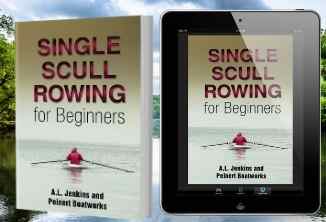From 'Single Scull Rowing'
Because sculls are built for speed, these rowing boats are narrow and, until you become used to handling them, can tip over easily. You should start only when the water is warm and you are prepared to get wet—but you probably won’t. If you can begin with an experienced mentor or rowing club, all the better. You should be a swimmer and have a float device plan or wear an approved life vest. If you should capsize, do not leave the boat but rather stay with it and use the boat, cushion and/or the oars as a flotation device with which to swim to shore. It’s safer to wear a life vest, but they can encumber your rowing. Consider an inflatable vest. They are expensive, generally over a hundred U.S. dollars. Totally worth it. Have a partner nearby to give you any needed assistance. Know and follow all rules associated with the body of water and community where you row.
I use a scull with pontoons that help to keep the boat stable, but I did tip it once when figuring out how to get into the scull in a non-ideal launch area. The water was warm and no problems resulted. Be prepared for this to happen to you. Consider phones and other pocket contents, watches, slippery rocks, cold water, and how you might get to safety if you take a tumble. Be prepared.
Wear sunglasses and a hat to protect your eyes. Use sunscreen. Gloves may help your hands from getting banged up. Especially in the early stages of learning to scull, it’s easy to bump the backs of your hands. I use biking gloves, but you can use more specialized gloves if you choose. Dress for the weather. When you scull, you assume responsibility for all involved risks.
You should read through the entire text first, then concentrate on the instruction section. Take your time, relax, and enjoy learning to row. Don't try to row too fast at the beginning; it will probably take a couple of outings before you feel comfortable and can fully enjoy the sport. The first time or two that you scull, you may want to practice your arm movements alone. Keep your legs extended and practice the rows. Then add and coordinate your leg movements.



